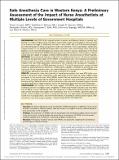| dc.contributor.author | Grace Umutesi, MPH,* Matthew D. McEvoy, MD,* Joseph R. Starnes, MPH,† Bantayehu Sileshi, MD,* Harrysone E. Atieli, PhD,‡ Kennedy Onyango, MBChB, MMed,§ and Mark W. Newton, MD | |
| dc.date.accessioned | 2022-01-30T08:24:47Z | |
| dc.date.available | 2022-01-30T08:24:47Z | |
| dc.date.issued | 2019 | |
| dc.identifier.uri | https://repository.maseno.ac.ke/handle/123456789/4769 | |
| dc.description | DOI: 10.1213/ANE.0000000000004266 | en_US |
| dc.description.abstract | BACKGROUND: Only 20% of the surgical burden in eastern sub-Saharan Africa is currently met,
leaving >17 million surgical cases annually in need of safe surgery and anesthesia. Similarly, there
is an extreme shortage of anesthesia providers in East Africa, with just 0.44 anesthesiologists
per 100,000 people in Kenya compared to 20.82 per 100,000 in the United States. Additionally,
surgical access is not equally distributed within countries, with rural settings often having the
greatest unmet need. We developed and tested a set of tools to assess if graduates of the Kenya
registered nurse anesthetist (KRNA) training program, who were placed in rural hospitals in Kenya,
would have any impact on surgical numbers, referral patterns, and economics of these hospitals.
METHODS: Cross-sectional data were collected from facility assessments in 9 referral hospitals
to evaluate the possible impact of the KRNAs on anesthesia care. The hospitals were grouped
based on both the number of beds and the assigned national hospital level. At each level, a
hospital that had KRNA graduates (intervention) was matched with comparison hospitals in
the same category with no KRNA graduates (control). The facility assessment survey included
questions capturing data on personnel, infrastructure, supplies, medications, procedures, and
outcomes. At the intervention sites, the medical directors of the hospitals and the KRNAs were
interviewed. Descriptive statistics were used to present the findings.
RESULTS: Intervention sites had a density of anesthesia providers that was 43% higher compared to the control sites. Intervention sites performed at least twice as many surgical cases
compared to the control sites. Most KRNAs stated that the anesthesia training program had
given them sufficient training and leadership skills to perform safe anesthesia in their clinical
practice setting. Medical directors at the intervention sites reported increased surgical volumes
and fewer referrals to larger hospitals due to the anesthesia gaps that had been addressed.
CONCLUSIONS: Our findings from this study suggest that KRNAs may be associated with an
increased volume of surgical cases completed in these rural Kenyan hospitals and may therefore be filling a known anesthetic void. The presence of skilled anesthesia providers is a first
step toward providing safe surgery and anesthesia care for all; however, significant gaps still
remain. Future analysis will focus on surgical outcomes, the appropriate anesthesia delivery
model for a rural population, and how the availability of anesthesia infrastructure impacts referral patterns and safe surgery capacity. (Anesth Analg 2019;129:1387–93) | en_US |
| dc.publisher | International Anesthesia Research | en_US |
| dc.title | Safe Anesthesia Care in Western Kenya: A Preliminary Assessment of the Impact of Nurse Anesthetists at Multiple Levels of Government Hospitals | en_US |
| dc.type | Article | en_US |

